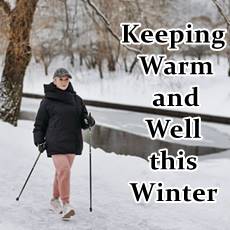Walking: health benefits
Walking is fun and good for you
Fact Checked
×All the content published in our website is fact checked to validate its accuracy.
Visit our guidelines web page to learn more about our strict processes regarding how we review our content's sources: reliable and reputable journals, media websites, universities, colleges, organizations, and professionals.
Our articles are based on scientific evidence, and the references are included in its footnotes, which are clickable links to sound scientific papers.
First published: 04.Nov.2024
Overview
Multiple studies have shown that physical activity improves the outcome of chronic conditions such as type-2 diabetes, cardiovascular disease, respiratory health, and reduces mortality. It has a positive impact on certain types of cancers and also improves quality of life, specially among the older adults. (1)
Walking is a physical activity and there is no reason that it shouldn't have a similar effect.
Walking is simple, accessible to everyone and also an easy way to start getting active and improving fitness.
Walking decreases the risk or severity of various health outcomes such as cardiovascular and cerebrovascular diseases, type 2 diabetes mellitus, cognitive impairment and dementia, while also improving mental well-being, sleep, and longevity. Ungvari, Z., Fazekas-Pongor, V., Csiszar, A. et al., (2023)(2)
This article will explore the health benefits of walking, and how to get started with your walking plan.
References and Further Reading
(1) Paluch, Amanda E et al., (2022). Daily steps and all-cause mortality: a meta-analysis of 15 international cohorts. The Lancet Public Health, Volume 7, Issue 3, e219 - e228. March 2022
(2) Ungvari, Z., Fazekas-Pongor, V., Csiszar, A. et al., (2023). The multifaceted benefits of walking for healthy aging: from Blue Zones to molecular mechanisms. GeroScience 45, 3211–3239 (2023). https://doi.org/10.1007/s11357-023-00873-8
(3) Sher, Leonid, (1996). Exercise, wellbeing, and endogenous molecules of mood. The Lancet, Volume 348, Issue 9025, 477. Aug. 17, 1996
(4) Hayes S, Forbes JF, Celis-Morales C et al., (2020). Association between walking pace and stroke incidence: findings from the UK Biobank prospective cohort study. Stroke. 2020;51:1388–95.
(5) Etzig, Cassandra; Gea, Alfredo; Martínez-González, Miguel Á.; Sullivan, Mark F. Jrf; Sullivan, Elixabethf; Bes-Rastrollo, Maira,, (2021). The association between self-perceived walking pace with the incidence of hypertension: the 'Seguimiento Universidad de Navarra' cohort. Journal of Hypertension 39(6):p 1188-1194, June 2021. | DOI: 10.1097/HJH.0000000000002788
(6) Boonpor J, Ho FK, Gray SR, Celis-Morales CA., (2022). Association of self-reported walking pace with type 2 diabetes incidence in the UK Biobank prospective cohort study. Mayo Clin Proc. 2022;97:1631–40
(7) Quan M, Xun P, Chen C, Wen J, Wang Y, Wang R, Chen P, He K., (2017). Walking pace and the risk of cognitive decline and dementia in elderly populations: a meta-analysis of prospective cohort studies. J Gerontol A Biol Sci Med Sci. 2017;72:266–70
(8) Stamatakis E, Kelly P, Strain T, Murtagh EM, Ding D, Murphy MH., (2018). Self-rated walking pace and all-cause, cardiovascular disease and cancer mortality: individual participant pooled analysis of 50 225 walkers from 11 population British cohorts. Br J Sports Med. 2018;52:761–8.
(9) Ikeda T, Inoue S, Konta T, et al. (2020). Can daily walking alone reduce pneumonia-related mortality among older people?. Sci Rep. 2020;10:8556.
(10) Sullivan Bisson AN, Robinson SA, Lachman ME., (2019). Walk to a better night of sleep: testing the relationship between physical activity and sleep. Sleep Health. 2019;5:487–94
(11) Green B, Pizzari T., (2017). Calf muscle strain injuries in sport: a systematic review of risk factors for injury. Br J Sports Med. 2017 Aug;51(16):1189-1194. doi: 10.1136/bjsports-2016-097177. Epub 2017 Mar 4. PMID: 28259848
(12) Tudor-Locke C, Han H, Aguiar EJ, et al, (2018). How fast is fast enough? Walking cadence (steps/min) as a practical estimate of intensity in adults: a narrative review. British Journal of Sports Medicine 2018;52:776-788
(13) Starting a Walking Program. American College of Sports Medicine - ACSM. Accessed 11.03.2024
About this Article
Walking: health benefits, A. Whittall
©2024 Fit-and-Well.com. First Published: 04.Nov.2024. Update scheduled for 04.Nov.2027. https://www.fit-and-well.com/fitness/walking-fitness-health-benefits.html
Tags: walking, diabetes, cancer, heart health, dementia, respiratory health, sleep, aging, bone health, fitness, exercise





